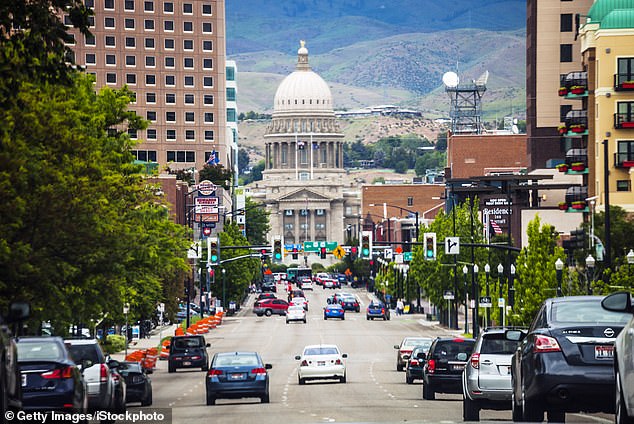A lot has changed in Boise, Idaho, in the last two years.
Since 2023, Idaho lawmakers have banned gender-transitioning care for minors, including surgery for anyone under 18, with providers facing up to 10 years in prison for violations.
State law also prevents public funds from covering gender-affirming medication and surgery for people of all ages and has cut using Medicaid to cover gender-transitioning care for adults.
Idaho has also made taking a minor over state lines to get an abortion without parental consent illegal, and has brought back the death penalty by firing squad.
The state of Idaho has been red since the Eisenhower administration, and often tops ‘most conservative’ state lists, along with with Utah, Wyoming and Oklahoma, reports The Center for Politics.
Idaho currently has a Republican-controlled Legislature, Governor’s office, and all four members of its Congress.
But Boise — the capital and largest city, home to 250,000 — remains the state’s lone liberal stronghold for over 20 years.
Now, some of its residents are feeling increasingly isolated as the state grows more right wing and conservatives move in from surrounding liberal states like California, Oregon and Washington.

Boise, Idaho’s capital and largest city with a population of 250,000, remains the state’s lone liberal stronghold

Since 2023, Idaho lawmakers have banned gender-transitioning care for minors and cut using Medicaid to cover gender-transitioning care for adults

Local realtor Barbara Dopp has lived in Boise for 35 years with her family
City Council members in Boise backed raising a Pride flag outside City Hall after a law was passed banning government buildings from displaying flags other than the US flag, state and local flags, the POW/MIA flag, or those from military branches and Native American tribes.
The bill was meant to force Boise to remove the Pride flag that had been flown at City Hall for years, but Boise Mayor Lauren McLean found a loophole and designated the Pride flag as an official city flag.
Now, state legislators again want it removed, and are planning new legislation for 2026 to force the city to take it down.
Local realtor Barbara Dopp said the closer you get to the city of Boise, the more liberal it gets, and that the city itself is home to many families that aren’t conservative.
‘There’s a great community here with a lot of families,’ Dopp told the Daily Mail.
‘People come to Boise for the lifestyle. The schools are great, livability is easy, it’s close to the mountains and water, close to restaurants and shopping.
‘You can be white water rafting or on foothill trails hiking or skiing or horseback riding all within an hour of each other.
‘There’s lots of sunshine and the outdoors is easy to enjoy.’

City Council members in Boise backed raising a Pride flag outside City Hall after a law was passed banning government buildings from displaying flags other than the US flag, state and local flags, the POW/MIA flag, or those from military branches and Native American tribes

The Boise Pride festival in full swing downtown in the city, which is liberal compared to the rest of Idaho

Boise has a vibrant arts scene and a thriving downtown district

The Boise Greenbelt, which runs for 25 miles along the Boise River, wraps around the city with views of the capitol

While Boise has a lively downtown scene, the city is surrounded by nature trails and lush greenery with plenty of resting spots
Dopp said that so many people have discovered the area that the only downside is you now have to add in traffic times for commuting hours.
She said the local schools rank very high for tests and reading, making the city appealing for young families.
‘The median home price is around $560,000 and we have a lot of new construction. But our fastest growing market is the luxury market, and homes over $1 million sell fast.
‘We’re getting buyers from Washington, California, Oregon, sometimes Utah.’
Some city residents like that Boise is standing firm as Idaho turns even redder under Donald Trump-era conservatism. But that doesn’t mean Boise’s liberals feel safe.
Idaho itself has become a magnet for Trump’s MAGA followers, as new arrivals seek an escape from liberal politics in California and Oregon.
The state keeps growing. Incomes are up, the budget is stable, and the population has surged, increasing 17 percent from 2010 to 2020, and another 8 percent since.
Many of the newcomers are more hard-right than long-time residents.

Republicans Raquel Debono (right with political commentator Emily Wilson, left) attend a MAGA party in New York

The population in Boise surged 17 percent from 2010 to 2020, and another 8 percent since

The median home price is around $560,000 in the city and there is a lot of new construction, locals say
Boise State University surveys show that recent arrivals are more likely to describe themselves as ‘strongly conservative’ and likely to pressure lawmakers to push aggressive right-wing agendas.
Idaho Gov. Brad Little has even used the term ‘COWs’ — short for California, Oregon, and Washington — to describe the wave of right wing newcomers.
And it is having a real impact. In addition to the wave of conservative laws passed over the last two years, still more are coming.
In fact, lawmakers are working with national conservative groups to craft a bill that would further crack down on immigration in the state and criminalize harboring undocumented people. It would also track the immigration status of public-school students, reports the Idaho Capital Sun.
Recently, the group held a free event at the Idaho State Museum on the ways in which state and local leaders can help enforce federal immigration laws. It was standing room only.
For LGBTQ groups, fear is growing.
‘By and large the people of Idaho are going to live and let live, but there are some people that are truly aggressive,’ said Nicole Leahy, a transgender woman who serves on the volunteer board of the LGBTQ nonprofit The Community Center.
She says the political climate has driven away volunteers and scared residents.

The clear divide in Idaho became more apparent in 2016, when Trump burst onto the scene as the Republican candidate and the MAGA movement was born

Locals hit the farmer’s market, held three times a week in Boise, Idaho, for farmers and artists to sell their goods

Boise State University surveys show that recent arrivals are more likely to describe themselves as ‘strongly conservative’
It’s no surprise why people are drawn to Boise, nicknamed the City of Trees. It’s charming, quiet, has a unique list of attractions, and one famous hometown local.
Boise native Aaron Paul, known for playing Jesse Pinkman in Breaking Bad, was born and raised there and still returns regularly for charity events.
Boise has unusual character, too. Boise’s State University’s football field, known locally as the ‘Smurf Turf,’ is actually an electric shade of blue.
Outdoor enthusiasts love The Boise Greenbelt, which runs for 25 miles along the Boise River and is great for walking, running and biking.
Runners and cyclists often cite it as one of the most beautiful urban pathways in America.
Boise is also home to a vibrant arts scene.
Its Freak Alley Gallery is part outdoor gallery, part living canvas that lives in the open-air art district and is filled with ever-changing murals and street art.
The city shows no signs of slowing down despite its liberal views in a conservative state.

Boise native Aaron Paul (right) played Jesse Pinkman alongside Bryan Cranston’s Walter White in the hit show Breaking Bad

A stunning tree sculpture in downtown Boise, which is home to a vibrant arts scene

Just last week, Boise voters re-elected two City Council members who voted in favor of raising a rainbow pride flag to wave outside City Hall
Between 2020 and 2023, its population exploded by 54,000 people.
In 2024, the plethora of bars and restaurants springing up as a result led Boise to be named ‘the coolest city in the Pacific Northwest’ by the Wall Street Journal.
Earlier this year, it was also recognized as the best city for young families to live, according to a study conducted by Elevate.
The study ranked the top 25 cities for working families and analyzed data from the 100 most populous US cities.
It assessed cities across three key categories: Work and Home, Child Care, and Environment, taking into account factors such as housing costs, median family income, work-from-home opportunities, child care affordability, and access to parks and public transit.









